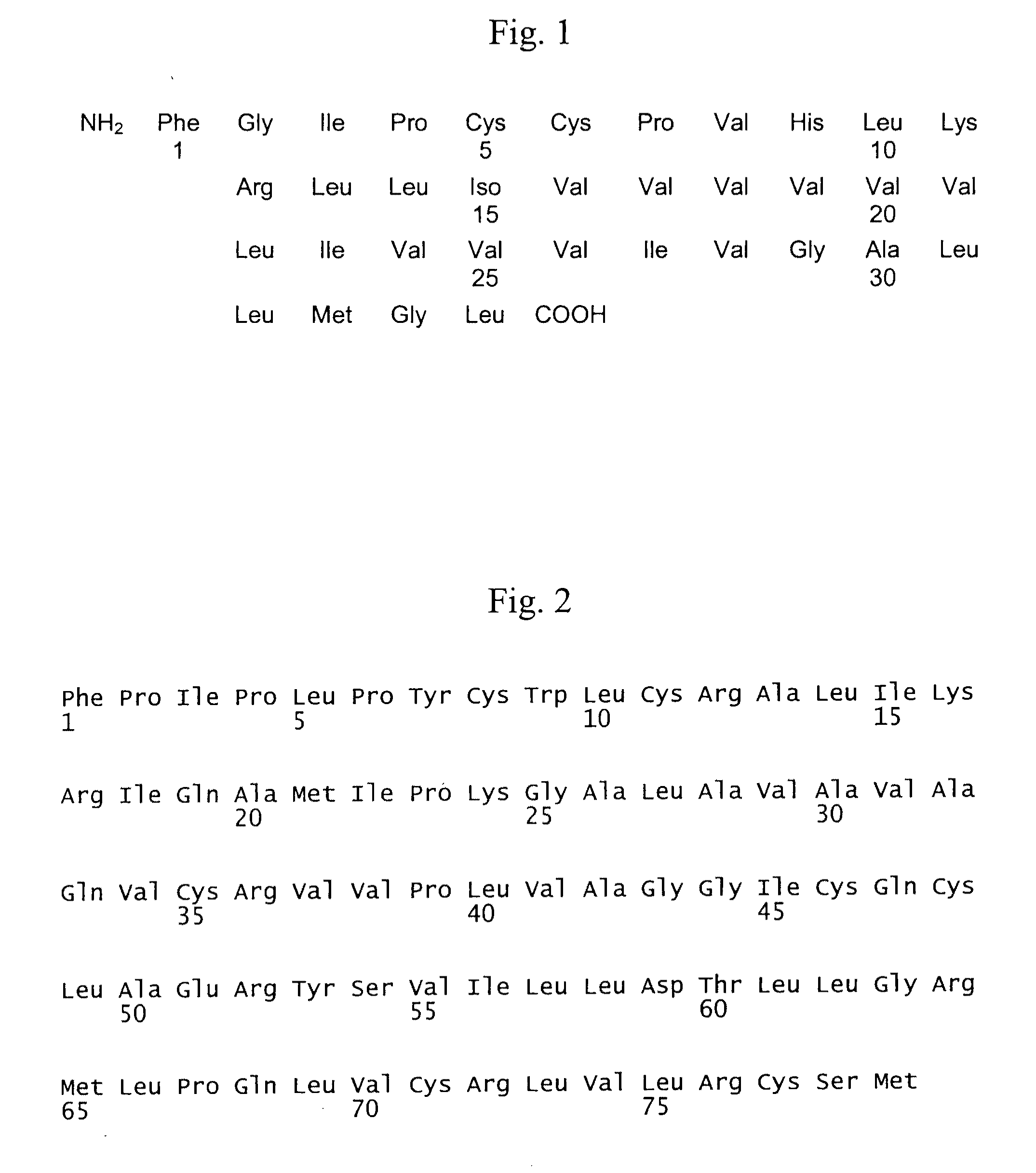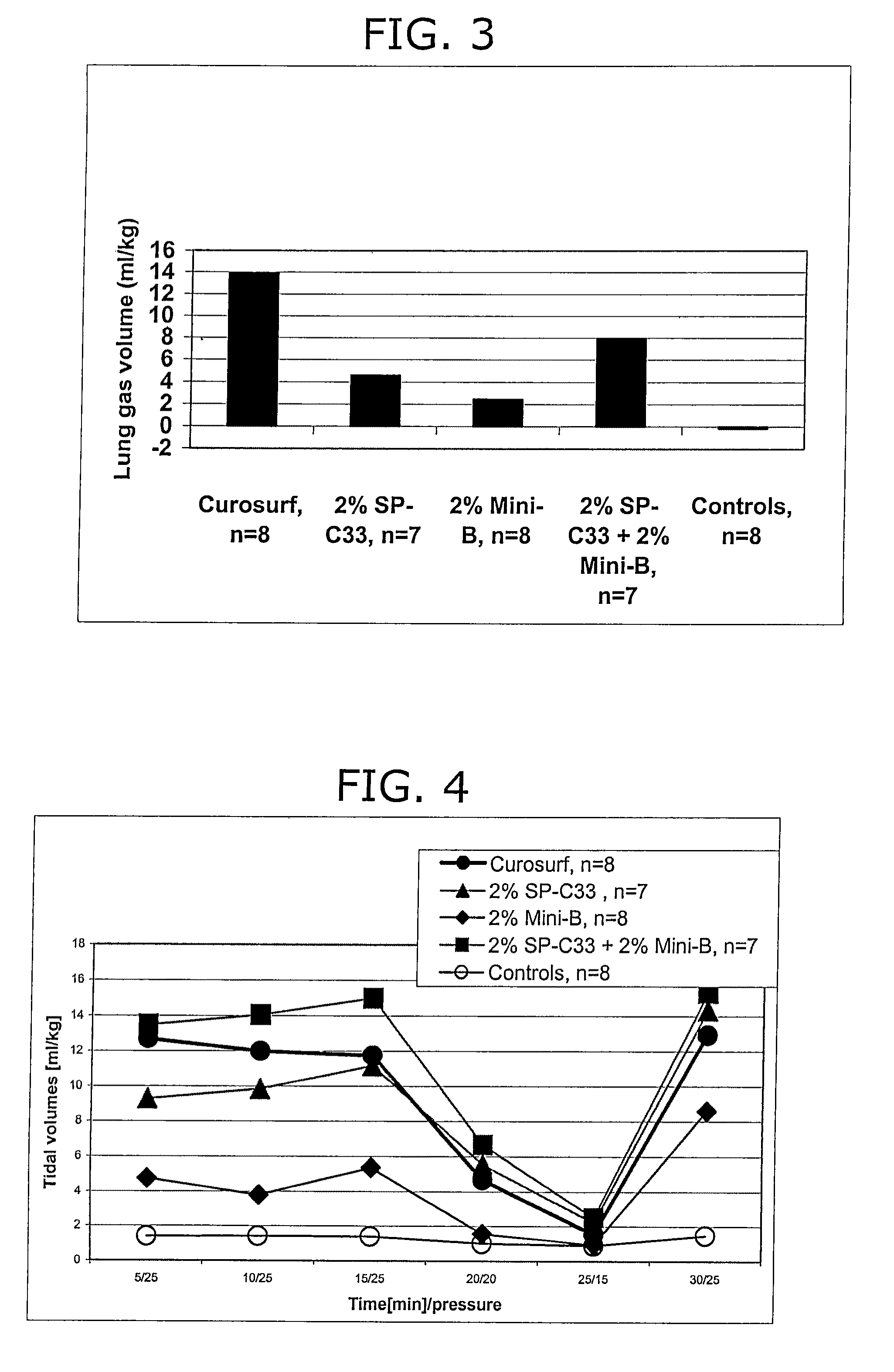Reconstituted surfactants having improved properties
a technology of reconstituted surfactants and properties, applied in the field of reconstituted surfactants, can solve the problems of complex development of clinically active reconstituted surfactants, malfunction of lung cells, and rise of reconstituted surfactants, and achieve the effect of improving alveolar patency
- Summary
- Abstract
- Description
- Claims
- Application Information
AI Technical Summary
Benefits of technology
Problems solved by technology
Method used
Image
Examples
example 1
Synthesis and Purification of the Polypeptides SP-C33(Leu)3 and SP-C33
[0131]The polypeptide SP-C33(Leu)31 was prepared by standard SPPS (Solid Phase Peptide Synthesis) methods based on Fmoc chemistry and consecutive TFA-cleavages. In total 186.0 g of crude SP-C33(Leu)31 were obtained. The polypeptide was purified by subjecting the material to counter current distribution (CCD) using H2O / n-BuOH / AcOEt / AcOH 4:1:4:1 as a biphasic solvent system. This purification yielded 78.9 g of SP-C33(Leu)31 with a purity of >60%. The final purification was carried out by preparative HPLC using PLRP-S as the stationary phase in a steel column of 50×300 mm applying a linear gradient of 25% B to 100% B in 75 minutes. The mobile phase consisted of buffer A=0.1% TFA in ACN / H2O 1:4 and buffer B=0.1% TFA in IPA. The purified polypeptide was dissolved in 90% AcOH and passed through a column packed with Dowex ion exchange resin (acetate form) to furnish, after lyophilisation, 5.8 g (=5.4%) of the final produ...
example 2
Synthesis and Purification of the Polypeptides ox Mini-B(Leu) and ox-Mini-B
[0135]The polypeptide ox-Mini-B(Leu) was prepared by standard SPPS (Solid Phase Peptide Synthesis) methods based on Fmoc chemistry and consecutive TFA-cleavages. The crude polypeptide was purified with preparative HPLC using a TFA system and isolated by lyophilisation. Air oxidation of the purified peptide yielded the monocyclic sequence with the disulfide bond between Cys1 and Cys33. The monocyclic peptide was purified with preparative HPLC using a TFA system and isolated by lyophilisation. The second disulfide bridge between Cys4 and Cys27 was formed using iodine. After oxidation, the product was purified with preparative HPLC using a TFA system and isolated by lyophilisation. 1.12 g (=1.7%) of the final compound were isolated with a purity of >89%.
[0136]The polypeptide ox Mini-B was prepared in an analogous manner.
example 3
In Vivo Experiments with a Reconstituted Surfactant Based on ox Mini-B and SP-C33
[0137]The surfactant preparations were assayed in premature newborn rabbits, obtained by hysterectomy at the gestational age of 27 days. The experiments were performed without applying a positive end expiratory pressure (PEEP). As the SP-C analog, the polypeptide referred to as SP-C33 was used which was prepared according to Example 1. As the analog of the protein SP-B, oxidized Mini-B (ox Mini-B) was used which was prepared according to Example 2.
[0138]The animals were treated at birth with reconstituted surfactant preparations containing, as lipid carrier, the phospholipid mixture DPPC:POPG in the ratio 68:31 w / w. The phospholipids were mixed with 2 or 4% w / w SPC-33, 2% w / w ox Mini-B, or 2% w / w SPC-33 plus 2% w / w ox Mini-B. Animals receiving the same dose of Curosurf® served as positive controls, and non-treated littermates served as negative controls. All surfactant preparations were administered at ...
PUM
| Property | Measurement | Unit |
|---|---|---|
| concentration | aaaaa | aaaaa |
| concentration | aaaaa | aaaaa |
| concentration | aaaaa | aaaaa |
Abstract
Description
Claims
Application Information
 Login to View More
Login to View More - R&D
- Intellectual Property
- Life Sciences
- Materials
- Tech Scout
- Unparalleled Data Quality
- Higher Quality Content
- 60% Fewer Hallucinations
Browse by: Latest US Patents, China's latest patents, Technical Efficacy Thesaurus, Application Domain, Technology Topic, Popular Technical Reports.
© 2025 PatSnap. All rights reserved.Legal|Privacy policy|Modern Slavery Act Transparency Statement|Sitemap|About US| Contact US: help@patsnap.com


